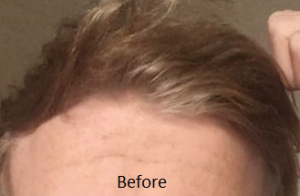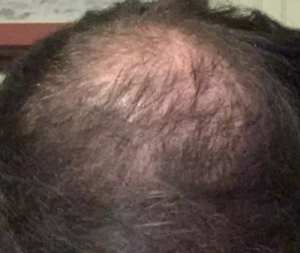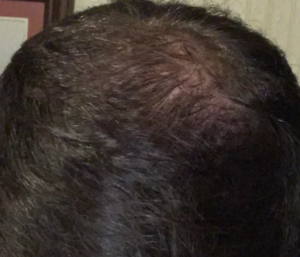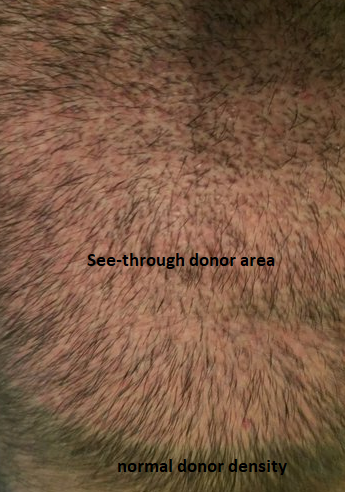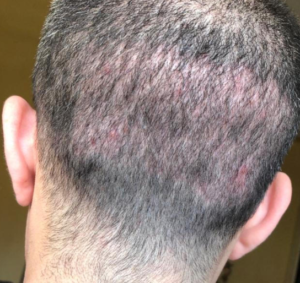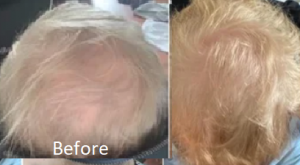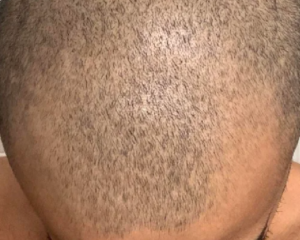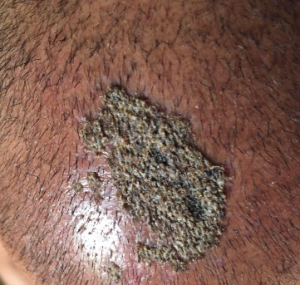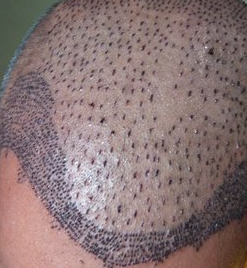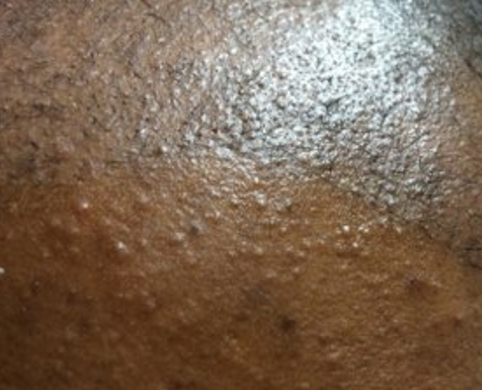Can you imagine having to walk around like this. The doctor has no sense that there was a technique to wash off the crusts the day of and the day after the surgery. Within 3 days of surgery you should look perfectly normal and able to go out in public without detection. By the third day, you should be able to resume full activities, heavy exercises if you wish. The recipient area requires daily washes to keep the recipient area free of crusts. I generally recommend the use of a sponge and supply my patient with a surgical sponge to fill with soapy water and press on the recipient area daily. By repeating this daily, all crusts can be washed off without any fear of losing grafts. If any crust are present, use a Q tip and dip it into soapy water, and roll it on the crusts and that will lift them off without dislodging them, but never rub them, just roll the Q tip on the recipient crust. I like to see no evidence of any crusting in the recipient area and the crusts from the donor area gone in 3 days with daily washing. Below are two patients, this one with terrible crusting on the left and one of my patients on day 6 on the right placed side by side for comparison purposes. Both patient are 6 days after the transplant. Can you tell which patient is minet?
This patient had 4,500 FUE grafts and you can see in the photo the difference between the donor area, which is a bit too high, and the normal hair density on the neck side of the photo. The surgery depleted the donor hair significantly. This is caused by either (1) very fine hair or (2) a low original donor density (something that the doctor can measure in advance).
When I teach doctors how to do a hair transplant, I always discuss randomness for graft placement. The doctor generally fights his tendencies for orderliness and orderliness means alignment of the grafts in columns or rows, not normal as you can see. When the hair grows, it will show the orderliness when you look carefully at it. Also, note the picket fence hairline, which again is not normal. As this man already has hair, these issues may not bother him, but it bothers my aesthetic sense of things.
Another photo of a man who had FUE and as a result had an over-harvested donor area. The donor area that was harvested was larger than the permanent zone so some of the transplanted hairs will not be permanent and may fall out in time. This depleted donor area could be treated with scalp micropigmentation
You have been using finasteride and minoxidil for only 45 days and these photos suggest that your hair is sensitive to finasteride and minoxidil. Your pattern of balding is a Norwood Class 3A with a huge forelock. The hair loss is around the forelock that is solid and not balding. You already show signs that it is reversing with the finasteride and minoxidil. Keep up the good work and make sure that you stay on it and let’s see what it looks like in 6 months from now.
Further FUE grafts harvested from the area shown where the previous grafts were removed will eventually make that area bald. The sides are reasonable additional donor source for FUE if this area was not harvested before. Strip surgery may also be possible for additional grafts. A careful discussion with an expert surgeons is critical to evaluate your residual donor hair supply and your Hair Mass Index.
https://sci-hub.cc/10.1016/j.bbrc.2016.02.099
There are several other publications also on sulforaphane, an isothiocyanate which has been extensively studied in relation to the hair follicle as well as other systems (such as cancer prevention): Example: Sulforaphane (SF maintains HF proliferation and active hair growth (anagen) during oxidative HF damage (Haslam et al. 2016). This compound is present in broccoli and can be found in tablet form sold as cancer preventative, increasing energy etc. I’m surprised no one is selling it yet to promote hair growth. In the meantime tell everyone to eat broccoli! (comments by Nilifer Farjom MD)
If you really had 6000 grafts, the doctor should have spread it throughout your head, not concentrate it in the front and sparsely place it behind throughout the remaining balding scalp, I don’t know what your doctor was thinking. To find out exactly what he did, ask your doctor for a copy of the surgical record and the count sheet as that will tell you what you actually got because I am having difficulty believing that there is 6000 grafts there.
Unfortunately, this is not an uncommon complaint; however, your donor density must have been very low to get such a depletion with 1500 FUE grafts. The only solution for this is Scalp Micropigmentation. I wrote a paper on this which can be seen in this post: https://baldingblog.com/2017/07/21/many-fue-grafts-many-fues-grafts-one-know-safe-limits/. Take a look at this site for more information on the only treatment for this: https://scalpmicropigmentation.com/gallery/bold-shaved-look/#!
At 8 months after a hair transplant, I would expect to see more growth. Go back to meet with your doctor and ask your doctor questions. I would expect to see more growth and I would hope that your doctor would take responsibility for the failure and make it ‘right’ financially for you. I would, but fortunately, I almost never see this type of problem.
Page 3 of 8

